Thanks for your support! If you make a purchase using our links in this article, we may make a commission. And, as an Amazon Associate, I earn from qualifying purchases. See the full disclosure here.
Unless you live in your RV full time, you might need to consider Indoor Versus Outdoor RV Storage Facilities to store your RV in the off-season. Even those who generally live in their RVs year-round might want to take an extended trip without their rig and need to consider their RV storage options.
Both indoor and outdoor RV storage facilities are viable options to consider. To determine which type of RV storage is best for you, we explore the pros and cons of both indoor and outdoor RV storage facilities.
We’ll also show you some great tips on how to prepare your motorhome or travel trailer for storage before you drop it off at the RV storage facility.
What’s the Best Way to Store an RV?
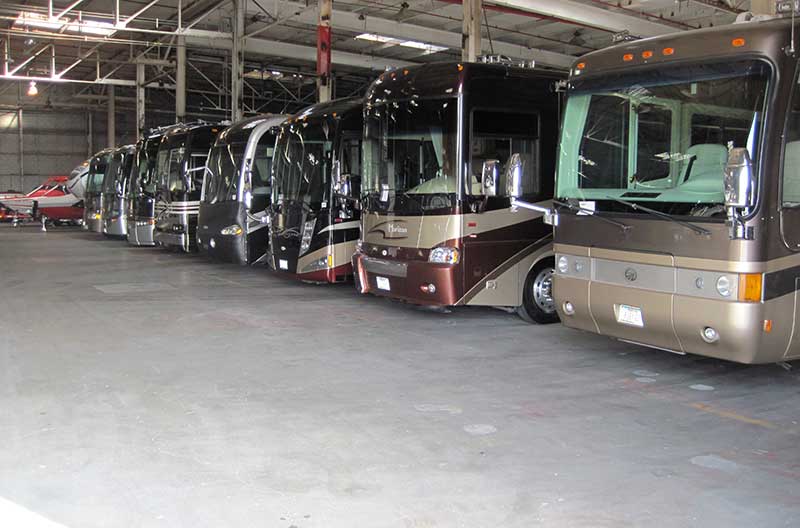
The best way to store an RV is the way that is most appropriate for you and your rig. You can store your RV on your property if you have the space. You might have a barn, shed or garage, or driveway that is perfect for storing smaller RVs or travel trailers.
Home storage allows you to check on it frequently and it will be less vulnerable to theft. Of course, if you do not have property or space at home then you will have to make the decision to find an RV storage facility. Check out our article called Can I Park an RV in My Driveway? for even more info!
If you choose indoor RV storage facilities, you will find that high-level locations have excellent features, but they can be expensive. Climate-controlled, indoor storage can have a monthly rate of $500 to over $1,000 a month in certain regions.
Outdoor storage that is covered with an awning or corrugated aluminum roofing is going to be less expensive but still provide your RV with some protection from the elements. Many outdoor RV storage facilities offer these upgraded spaces for an additional cost.
Outdoor storage will not provide the same protection as the other options but will cost less. Outdoor RV storage facilities make it easy to get in and out of the security door with your own keyless entry code and have many security features to keep your RV safe.
Pros and Cons of Indoor RV Storage Facilities
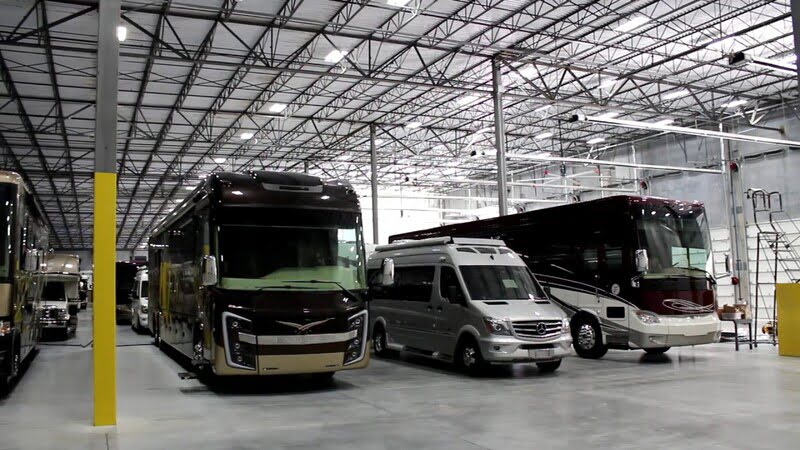
The Pros
There are a lot of great reasons to store your motorhome or travel trailer at an indoor RV storage facility. Keeping it inside helps protect it from weather, inconsistent temperatures, and UV radiation. Indoor storage can also keep pests, dirt, and contaminants from harming your coach. Most importantly, an RV storage facility gives added protection from theft or vandalism.
Indoor storage will help your RV to look and run better for a longer time. If you have climate-controlled storage, you can probably avoid having to take everything out for the storage period. Items such as electronics or other gear should fare well under climate control conditions.
Many indoor RV storage facilities offer additional services like:
- Valet service where they park your RV for you from a drop off lot
- An external RV wash before they park it
- Engine start-up one or two times a month
- Battery charging service once a month
- Tire monitoring and refill when needed
- Holding tank dumping
- Filling up your freshwater tank 24 hours before you’re ready to leave
- Turning on your RV refrigerator a day before you leave to have it cold for you
- Parking your coach in a pickup lot that’s easy to maneuver out of when you’re ready to go.
The Cons
The biggest negative of using an indoor facility is the cost. You will want to weigh your options carefully and consider the cost. It might be worth it to keep that million-dollar luxury Class A motorhome inside when not in use. Whatever your investment, you want to have it around and running smoothly for as long as possible.
Other factors to consider are the logistics and locations of indoor RV storage facilities. There are many more outdoor facilities around than indoors. You may have to travel a long distance to find an indoor RV storage facility depending on where you live.
Logistically, when you and your family are ready to head out, you can’t just go to the storage location and pick up your rig. Due to their procedures and other restrictions, the facility may require you to call them days in advance to have your RV ready for you. If you enjoy impromptu RV trips, you may want to consider a different storage method.
Pros and Cons of Outdoor RV Storage Facilities
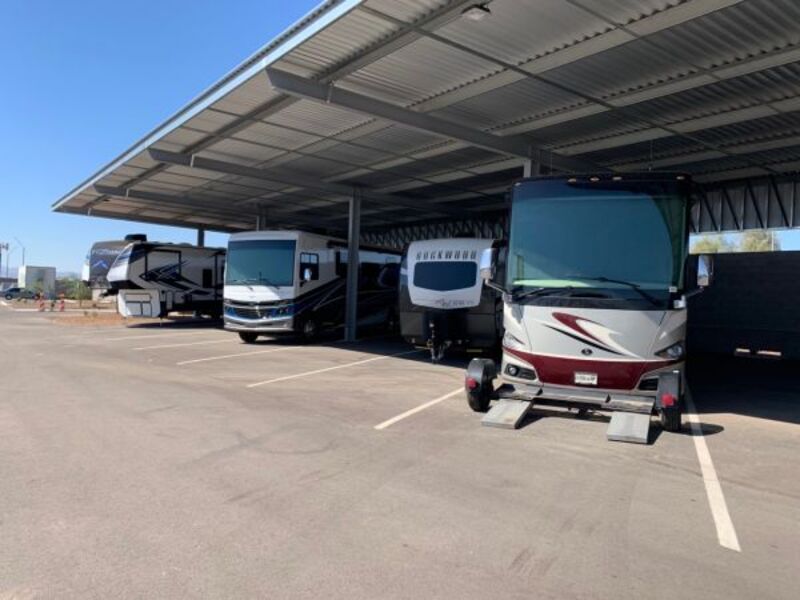
The Pros
Certainly, the major pro of outdoor storage is the cost. Outdoor RV storage facilities can be your local self-storage facility or a location that is specifically for storing RVs, boats, and other large equipment.
These locations have excellent security features like proper fencing, lighting at night, security cameras, a single security code entrance, and an on-site manager that lives on the property. They also have third-party security companies or the police department make regular inspections throughout the night for added protection.
Many outdoor locations offer covered RV storage facility sections as an upgrade. Corrugated aluminum or another type of roof material protects against direct sunlight and precipitation. This roof can save your coach from UV radiation, the interior heating up from direct sunlight, and hail damage.
The Cons
Cons of putting your motorhome or travel trailer in outdoor storage include the problems that come with leaving your RV outside. Using an RV cover and RV tire covers can minimize many of the issues that come with long-term outdoor exposure. A good maintenance routine can also avoid cracking seams, tire dry rot, and other issues.
Pests like insects and rodents look at RVs as dry warm places to make their home. Since the beginning of the Revitalization Period of the Modern Era (2008-2019), RV manufacturers have sealed the underbelly of RVs, making it harder for pests to find their way in.
Make sure you complete a thorough maintenance checklist run-through of your RV, including the underbelly, making sure everything is sealed up tight.
How to Prepare Your RV for Long Term Storage
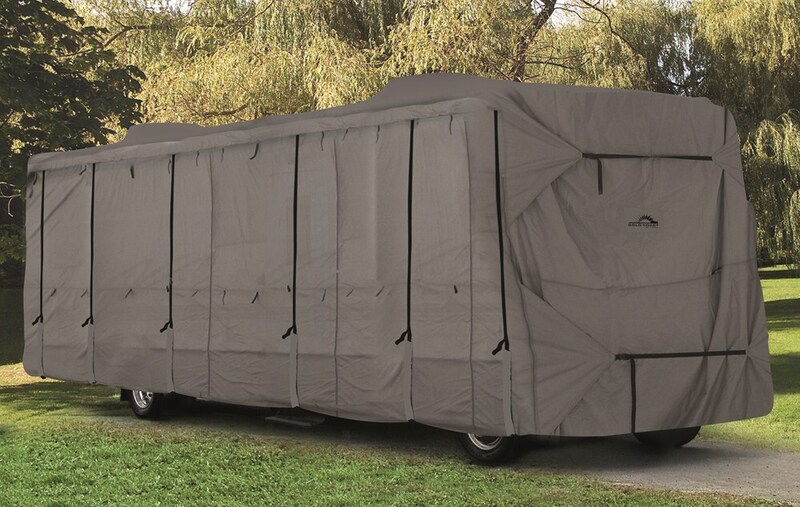
As we saw, both indoor and outdoor storage have their positives and negatives. Whichever you decide, there will be things you will need to do so you do not come back to your camper in the spring with issues.
You may be able to skip some of these if your RV is in a climate-controlled storage unit, but even their staff will recommend performing the full checklist.
Winterize Your Plumbing Before Storing Your RV
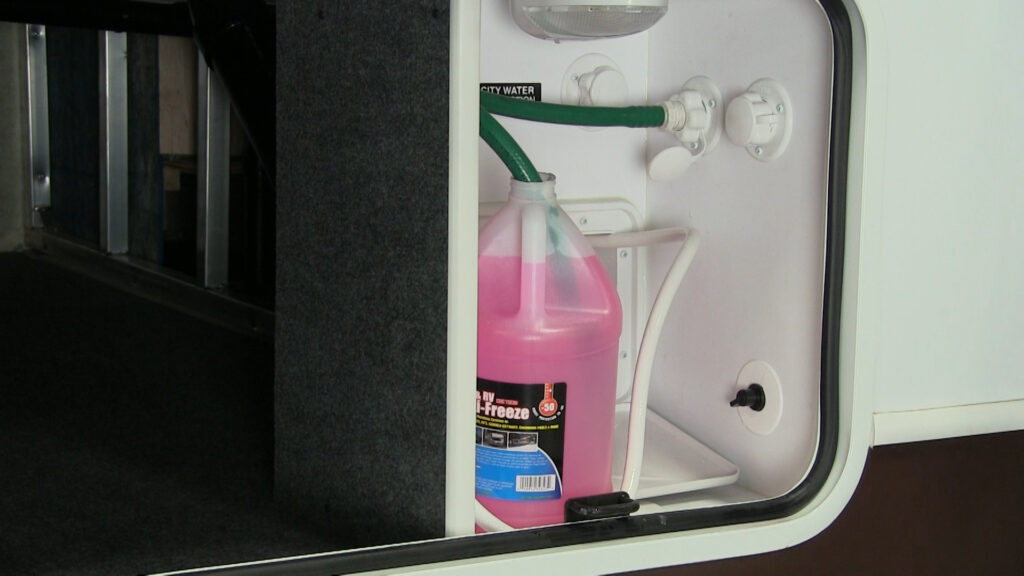
The most critical step in winterizing your RV is to make sure there is no water left in the plumbing system that can freeze and break the lines. Winterizing is generally a do-it-yourself process but consult your owner’s manual for directions. You can hire a mobile RV technician to do it for you, but our article called Do You Have to Winterize an RV or Camper? walks you through the process.
Winterizing will require draining the fresh water and wastewater tanks. You then pump non-toxic RV antifreeze through the entire water system and let it run through the sinks and shower.
Wash Your RV Thoroughly
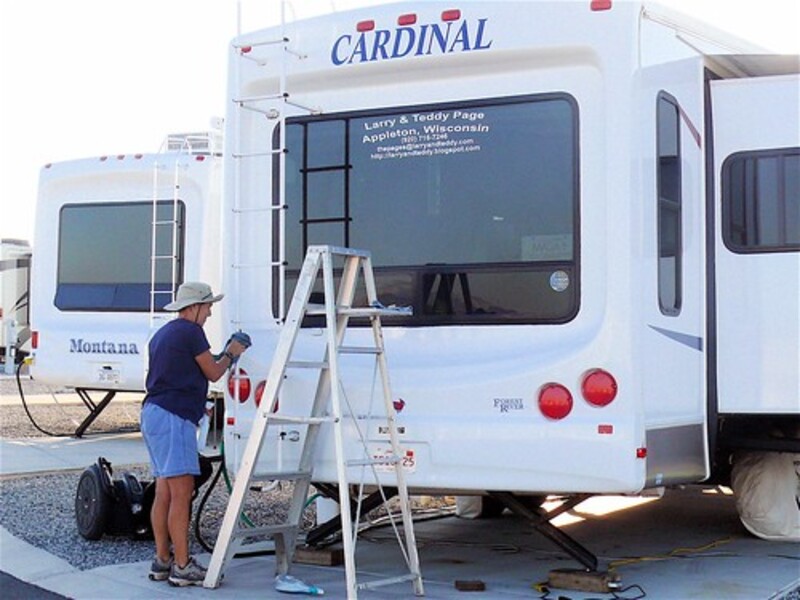
Washing your RV includes cleaning the exterior and interior. Make sure your awning fabric is clean and dry before stowing the awnings.
This is also a good time to inspect roof seams, body seams, and window seals for any cracks or openings that would allow water to penetrate. This ensures that you are not storing your RV with any contaminants on it.
Pick a Space With Good Security
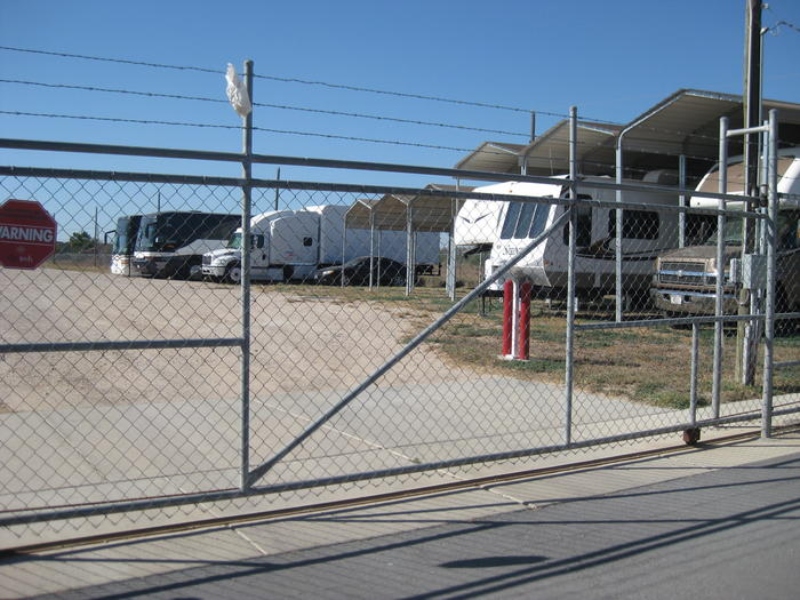
If you choose an outdoor RV storage facility, pick a space with good security. You want a storage area that is fenced and monitored to keep someone from stealing your trailer. Try and locate the security cameras and park your RV so it will be seen. This way, the on-site manager can have a constant view of your rig.
A significant portion of outdoor RV storage facilities are not paved. If you choose one of these, make sure they keep the lot groomed so pests cannot use the weeds as ladders into your RV. Stay away from trees to avoid falling branches during high winds and “paratrooper” pests.
The best way to protect your rig is to purchase an RV cover made of breathable material to promote air circulation and to prevent mold and mildew.
Prepare Your Tires for the RV Storage Facility
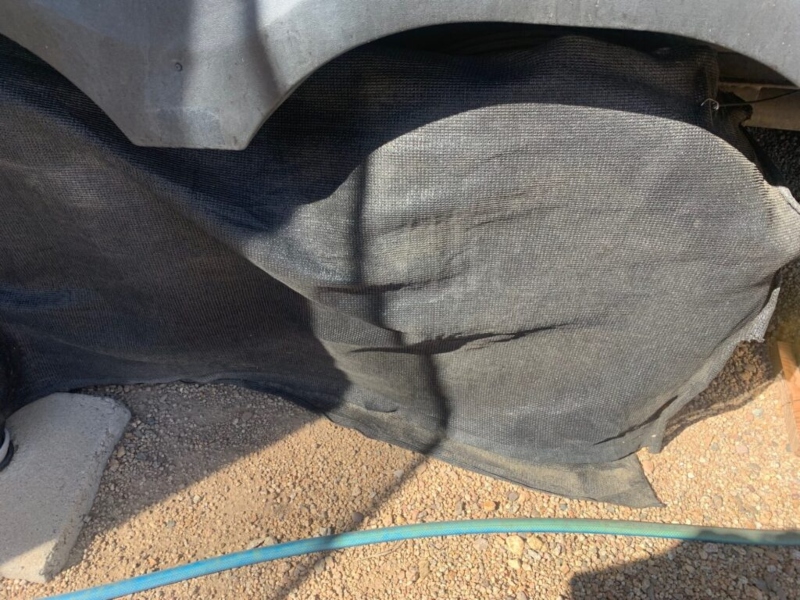
Inflate your RV tires to the manufacturer’s recommended pressure and place jack pads between the tires and the ground. You want to make sure the tires are not making any contact with the ground. Also, use RV tire covers or something else to protect them from the sun and harmful UV rays.
Other RV Storage Facility Preparations
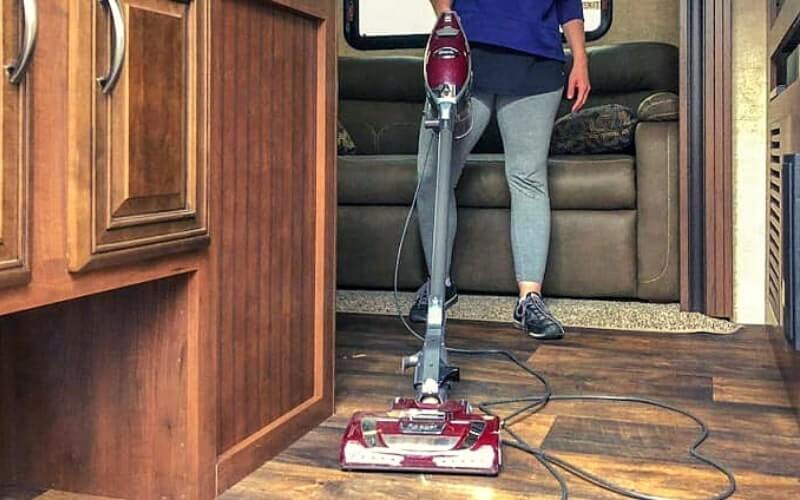
Make sure you inspect the underside of your unit thoroughly. Look for any place where mice and rodents can get inside. Seal any potential pathways using silicone caulk.
Remove all food items and use mouse and ant traps in your cabinets. Defrost and clean the refrigerator and put baking soda inside to prevent odors.
Make sure your batteries are prepared for winter storage by keeping them fully charged. If possible, check them about once a month. Remove batteries if possible and store them inside.
You may want to bring your RV batteries home with you and plug them into a charger for 8 hours once a month to keep them fresh. In cold climates, a partially discharged battery will freeze quicker than a fully-charged battery.
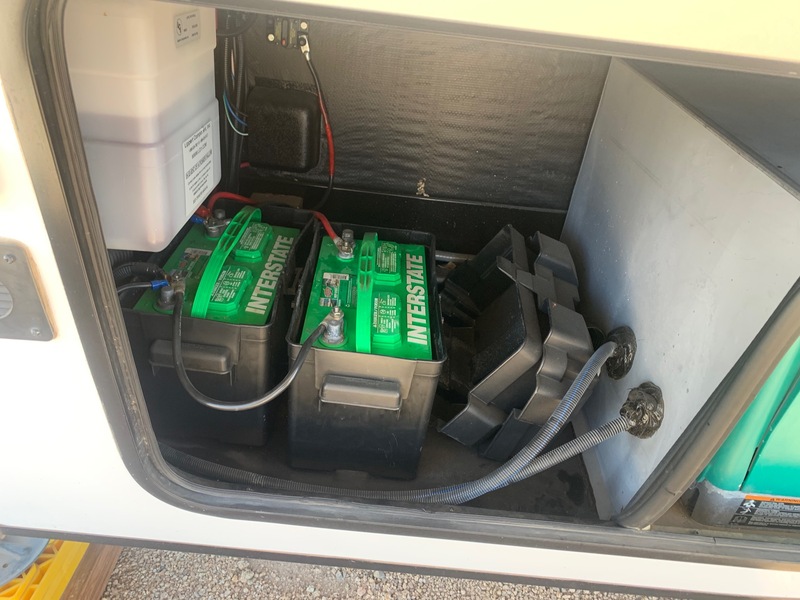
Close all slides so the weather will not damage the seals. You also do not want snow or debris accumulating on the top of the slide-out.
If you have a motorhome, fill the fuel tank and add a fuel stabilizer. Then run the engine and the generator to make sure the stabilizer is through the system. It is also recommended that you change your oil and oil filter prior to storage.
Wrapping Up
We discussed the pros and cons of indoor and outdoor storage for your RV. There is no right answer since it depends on your RV lifestyle. Regardless of the RV storage facility type you choose, you must prepare your RV for storage either way. When prepared correctly, your motorhome or travel trailer will be in the best shape to head out for the next RV season.
1. Do You Have to Winterize an RV or Camper?
2. 35 Biggest RV Beginner Mistakes to Avoid!
3. 25 Essential Tips for Storing an RV in Hot Weather
4. 10 Steps to Properly Store Your RV for Winter Without Doing Damage
5. Keep Your RV Safe with the WhereSafe GPS Tracker
About the Author
Terri Nighswonger – Author and Full Time RVer
Terri Nighswonger and her husband Todd have been RVing and work camping for six years with their Cavalier King Charles Spaniel, Newton, and their Minnie Australian Shepherd, Remi.
In Addition to the RVBlogger team, Terri has written for RV Life and RV Camping Magazine and is always excited to talk about her passion for RVing and her knowledge and experience in work camping.
Writing is Terri’s passion, but she also loves hiking, kayaking, walking her dogs, and anything she can do outdoors.
They originate from the Midwest but plan to enjoy the West for a few years, wintering in Arizona and summering wherever the road may lead.


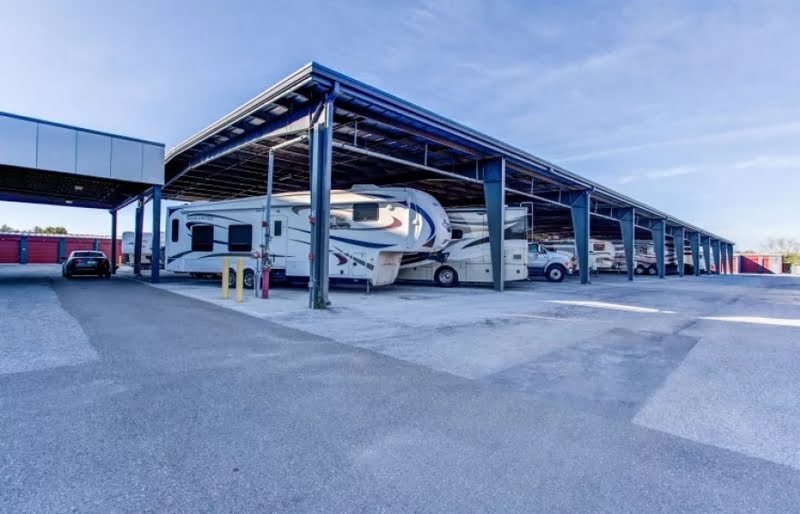
Hello!
I just ran across your blog.
We recently bought a 5th wheel and are using it as an extra mother in law style house to support the rapid rise in property taxes here in Austin TX. I’d really like to minimize the amount of work we need to do to protect the roof and the slides, since they are out most of the time, but I cannot find a good resource to build a roof or buy a premade one that will fit slides. I seem to keep running into “just maintain the roof and it will be fine” BUT eventually I know it will wear out. We opted for the 5th wheel over an Airstream because we ALSO have an airstream and we are both big people. We can barely stand up in the Airstream and using the sink to cook in the kitchen is a serious pain in the back, so we wanted the freedom to be able to move into the 5th wheel if we need to rent out the main house at some point while starting a family costs etc.
Long winded way of saying- what is the best way to turn a 5th wheel with 2 slideouts (Sandpiper) into a permanent tiny home? can we build a roof around the existing structure using the existing structure?